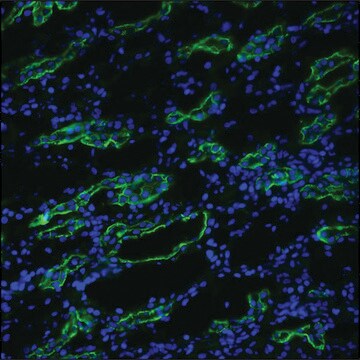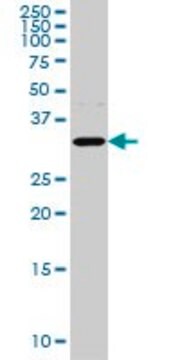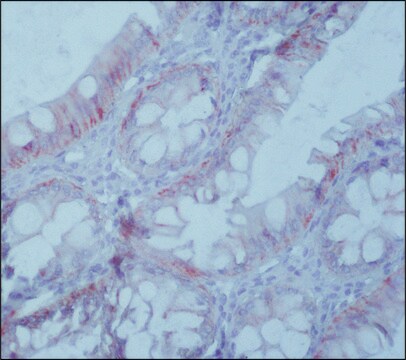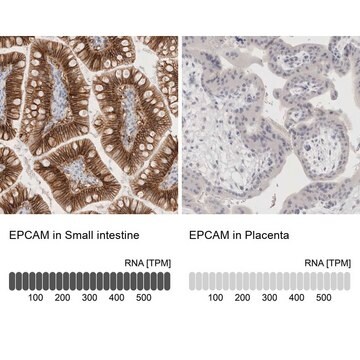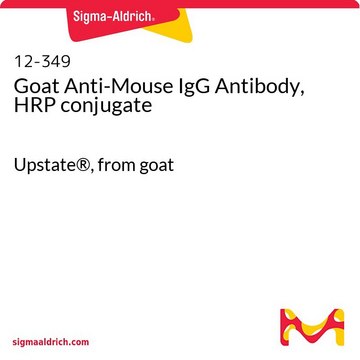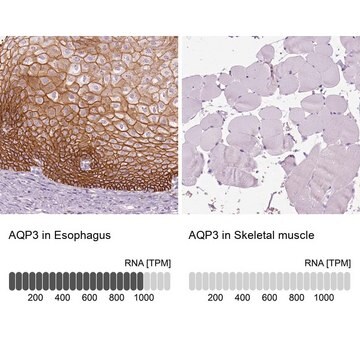A0303
Anti-Water Channel Aquaporin 3 antibody produced in rabbit
affinity isolated antibody
Synonym(s):
anti-AQP3
Sign Into View Organizational & Contract Pricing
All Photos(2)
About This Item
Recommended Products
biological source
rabbit
Quality Level
conjugate
unconjugated
antibody form
affinity isolated antibody
antibody product type
primary antibodies
clone
polyclonal
species reactivity
rat, mouse
technique(s)
immunohistochemistry: suitable using Mouse kidney sections
western blot: 1:200 using Rat kidney membranes
UniProt accession no.
storage temp.
−20°C
target post-translational modification
unmodified
Gene Information
mouse ... Aqp3(11828)
rat ... Aqp3(65133)
General description
Aquaporins function in the movement of water and small solutes across the cell membrane. Aquaporins are widely distributed from bacteria to plants and animals. In E. coli, one aquaporin has been identified that is named AQP-Z. In the plant Arabidopsis thaliana, over 9 AQPs have been characterized. In mammals, at least 11 different AQPs have been cloned. AQP3 provides kidney medullary collecting ducts with high permeability to water, permitting water to move in the direction of an osmotic gradient and may play an important role in gastrointestinal tract water transport. AQP3 and AQP4 are located at the basolateral part of epithelial cells in kidney, colon and trachea.
Rabbit polyclonal anti-Water Channel Aquaporin 3 recognizes rat and mouse aquaporin 3 transport proteins.
Immunogen
synthetic peptide corresponding to amino acids 275-292 of rat aquaporin 3 (with additional N-terminal lysine and tyrosine) conjugated to KLH with glutaraldehyde
Application
Applications in which this antibody has been used successfully, and the associated peer-reviewed papers, are given below.
Immunofluorescence (1 paper)
Immunofluorescence (1 paper)
Rabbit anti-AQP3 antibody was used in western blot analysis to identify the level of aquaporin 3 in E. solidaginis larvae. Anti-AQP3 was diluted 1:200 in 5% nonfat dry milk and incubated with the membrane for 2hrs at 21 degrees C.
Rabbit polyclonal anti-Water Channel Aquaporin 3 is used to tag aquaporin 3 for detection and quantitation by immunocytochemical and immunohistochemical (IHC) techniques. It is used as a probe to determine the presence and roles of aquaporin 3 in kidney medullary collecting ducts and the basolateral surfaces of epithelial cells involved in water transport.
Physical form
Lyophilized from a solution containing phosphate buffered saline, pH 7.4, 1% BSA, and 0.05% sodium azide
Preparation Note
Affinity isolated on immobilized Protein A
Disclaimer
Unless otherwise stated in our catalog or other company documentation accompanying the product(s), our products are intended for research use only and are not to be used for any other purpose, which includes but is not limited to, unauthorized commercial uses, in vitro diagnostic uses, ex vivo or in vivo therapeutic uses or any type of consumption or application to humans or animals.
Not finding the right product?
Try our Product Selector Tool.
Storage Class Code
11 - Combustible Solids
WGK
WGK 3
Flash Point(F)
Not applicable
Flash Point(C)
Not applicable
Personal Protective Equipment
dust mask type N95 (US), Eyeshields, Gloves
Choose from one of the most recent versions:
Already Own This Product?
Find documentation for the products that you have recently purchased in the Document Library.
K Ishibashi et al.
The American journal of physiology, 272(2 Pt 2), F235-F241 (1997-02-01)
Aquaporin-3 (AQP3) is unique in its structure (lowest homology with other aquaporins) and in its function (significantly conductive to both small nonelectrolytes and water). However, there is a controversy among researchers on its water transport and induction by dehydration. We
C A Ecelbarger et al.
The American journal of physiology, 269(5 Pt 2), F663-F672 (1995-11-01)
The aquaporins are a family of water channels expressed in several water-transporting tissues, including the kidney. We have used a peptide-derived, affinity-purified polyclonal antibody to aquaporin-3 (AQP-3) to investigate its localization and regulation in the kidney. Immunoblotting experiments showed expression
Susumu Yoshie et al.
Journal of cellular physiology (2019-02-05)
Functional central airway epithelial cells (CAECs) from induced pluripotent stem cells (iPSCs) are an attractive potential cell source for central airway regeneration. The central airway epithelium, such as the tracheal epithelium, is composed of ciliated cells, goblet cells, and basal
Susumu Yoshie et al.
Journal of cellular physiology, 234(9), 15951-15962 (2019-02-05)
Functional central airway epithelial cells (CAECs) from induced pluripotent stem cells (iPSCs) are an attractive potential cell source for central airway regeneration. The central airway epithelium, such as the tracheal epithelium, is composed of ciliated cells, goblet cells, and basal
M Echevarria et al.
Proceedings of the National Academy of Sciences of the United States of America, 91(23), 10997-11001 (1994-11-08)
The terminal part of the inner medullary collecting duct exhibits a high degree of water permeability that is independent of increased intracellular cAMP and not accounted for by the activity of the known renal epithelial water channels CHIP28 (28-kDa channel-forming
Our team of scientists has experience in all areas of research including Life Science, Material Science, Chemical Synthesis, Chromatography, Analytical and many others.
Contact Technical Service